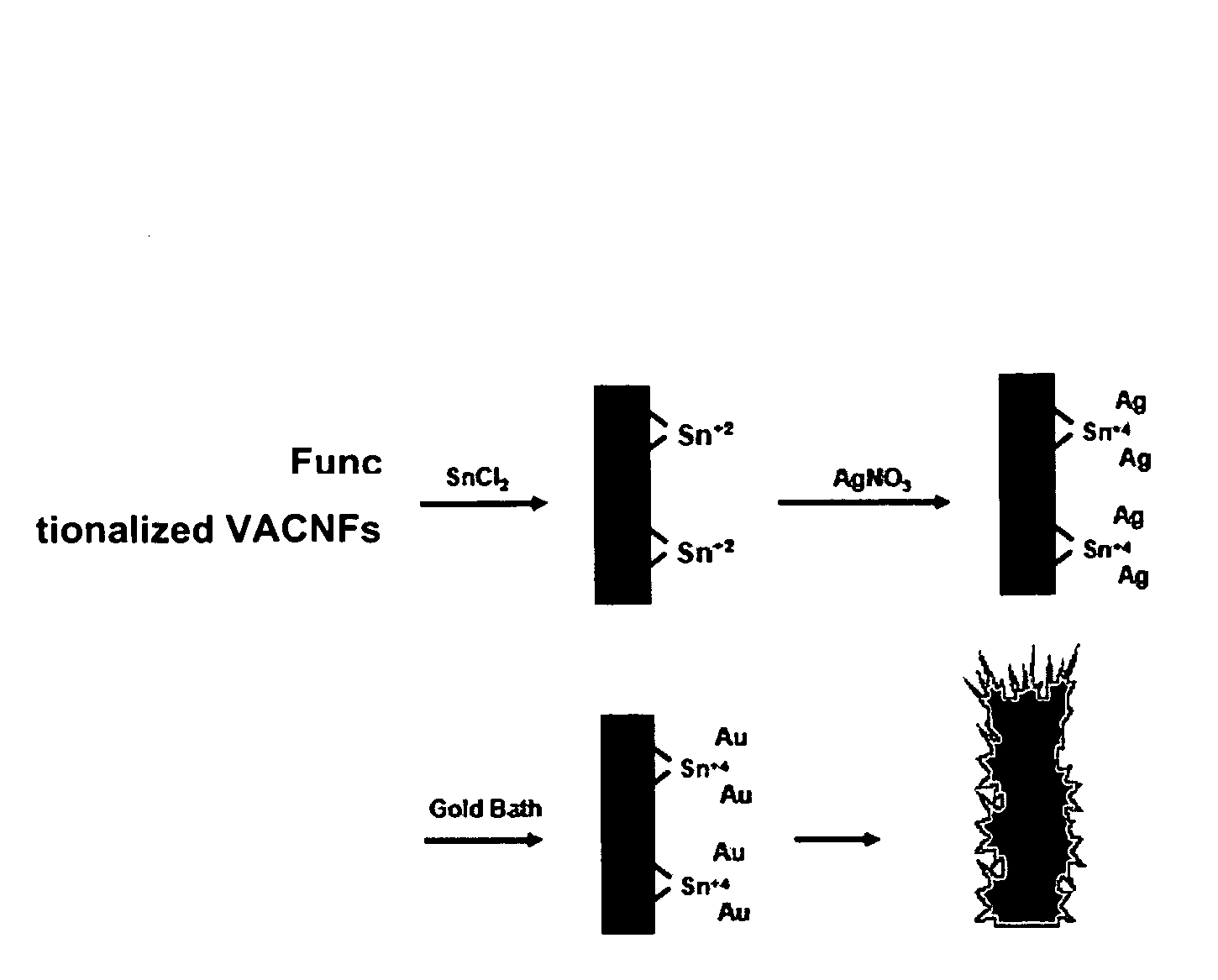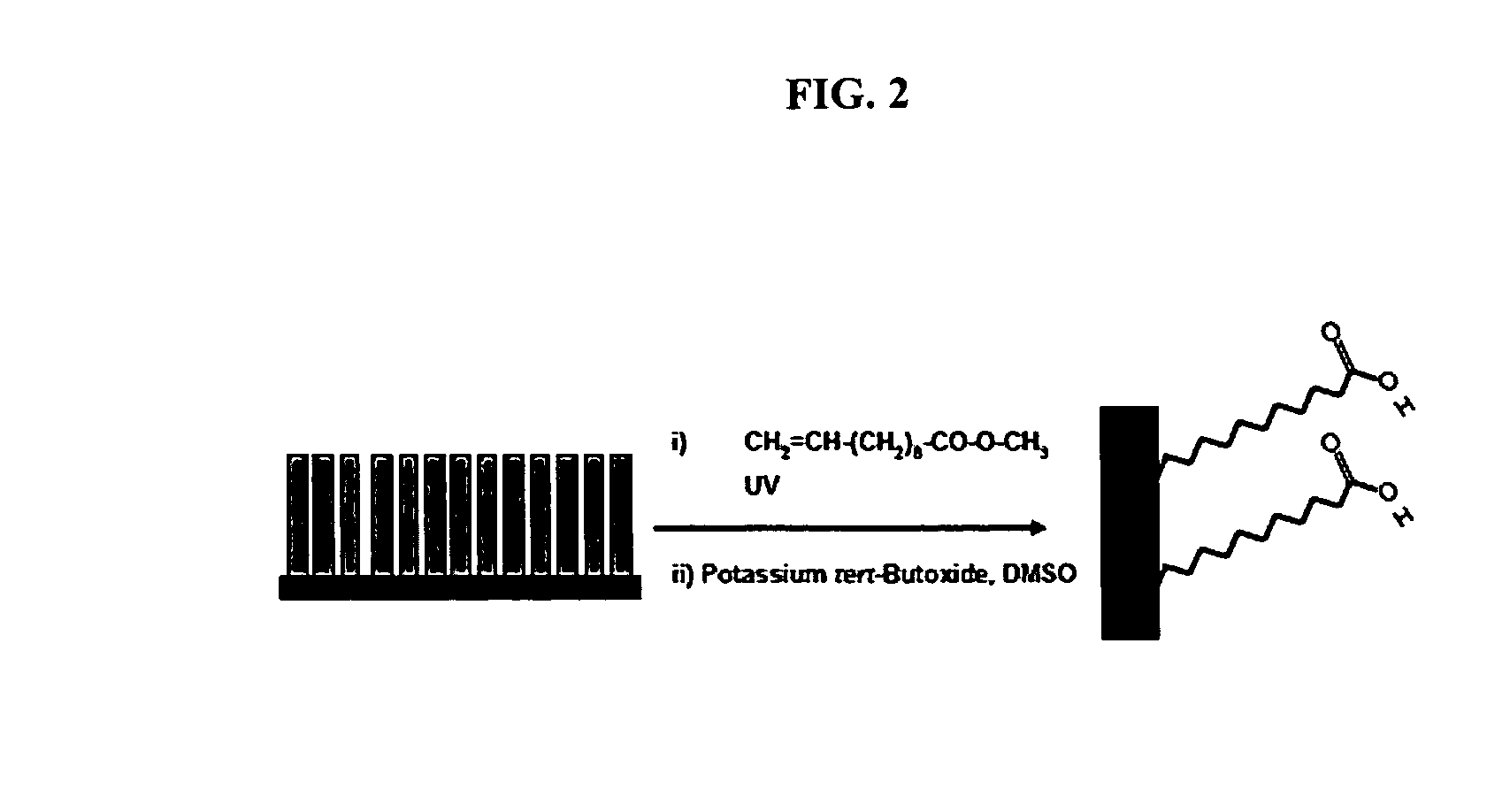Metal-coated vertically aligned carbon nanofibers
a technology of carbon nanofibers and vertical alignments, which is applied in the direction of cell components, coatings, transportation and packaging, etc., can solve the problems of reducing the effective surface area of the underlying carbon platform, so as to achieve high capacitance values, high surface area, and high surface area
- Summary
- Abstract
- Description
- Claims
- Application Information
AI Technical Summary
Benefits of technology
Problems solved by technology
Method used
Image
Examples
example 1
Synthesis of Vertically Aligned Carbon Nanofibers
[0033]Vertically aligned carbon nanofibers were grown using DC plasma-enhanced chemical vapor deposition (DC-PECVD) in a custom-built chamber. (See Cassell, A. M.; Ye, Q.; Cruden, B. A.; Li, J.; Sarrazin, P. C.; Ng, H. T.; Han, J.; Meyyappan, M. Nanotechnology 2004, 15, 9.) The nanofibers shown in FIG. 1 were grown on silicon nitride substrates that were covered with a thin multilayer film consisting of 50 nm of molybdenum, followed by 20 nm of titanium, and finally 20 nm nickel as the top layer. Typical growth conditions used flow rates of 80 standard cubic centimeters per minute (sccm) ammonia and 30 sccm acetylene, with a chamber pressure of 4 torr and a DC power of 360 watts. Under these growth conditions, the nanofibers have an average diameter ˜80 nm and are nearly cylindrical and are nearly all vertically aligned. The length of the fibers can be controlled with the time of growth. All fibers used here were grown for 15 minutes,...
example 2
Functionalization of Vertically Aligned Carbon Nanofibers
[0034]Vertically aligned carbon nanofibers were functionalized with terminal reactive moieties as illustrated in FIG. 2. Specifically, carbon nanofibers were reacted with undecylenic acid methyl ester (Aldrich) in a quartz covered, nitrogen purged reaction chamber. Functionalization was carried out by sandwiching a drop of the ester between the sample and a small quartz window, used to minimize evaporation. The entire chamber was illuminated with 254 nm UV light for 16 to 18 hours. To remove non-covalently attached reactants, the samples were washed in chloroform for 30 minutes, and then immersed in methanol to rinse. These washing steps were performed twice. The ester was deprotected by reacting the samples in a potassium tert-butoxide slurry in DMSO (˜250 mg in ˜10 mL) for 5 minutes. Samples were then washed in 0.1 M HCl. Deprotection left the carbon nanofiber surfaces functionalized with terminal carboxylic acid moieties.
example 3
Preparation of Metal-Coated Vertically Aligned Carbon Nanofibers Using Electroless Deposition
[0035]Functionalized vertically aligned carbon nanofibers were coated with metal according to the scheme outlined in FIG. 3. Functionalized nanofibers were immersed in methanol and then in a tin sensitizing solution consisting of 0.026M SnCl2, and 0.07M trifluoroacetic acid in a 50:50 methanol:DI H2O solution for 45 minutes at room temperature. The samples were removed from the tin solution, rinsed by immersion in methanol, and then activated with silver by placing them in 5 mL of ammonical silver nitrate solution (0.03M AgNO3) for 15 minutes. The samples were removed from the silver nitrate solution and rinsed by immersion in methanol. The samples were then placed in individual gold baths in a refrigerator at 6° C. and left for 1 to 22 hours. The gold baths consisted of 0.127M Na2SO3, 0.025M NaHCO3, 0.625M formaldehyde and 8 mM Na2Au(SO3)2 (Technic Oromerse Part B gold solution). The pH of ...
PUM
| Property | Measurement | Unit |
|---|---|---|
| Diameter | aaaaa | aaaaa |
| Length | aaaaa | aaaaa |
| Density | aaaaa | aaaaa |
Abstract
Description
Claims
Application Information
 Login to View More
Login to View More - R&D
- Intellectual Property
- Life Sciences
- Materials
- Tech Scout
- Unparalleled Data Quality
- Higher Quality Content
- 60% Fewer Hallucinations
Browse by: Latest US Patents, China's latest patents, Technical Efficacy Thesaurus, Application Domain, Technology Topic, Popular Technical Reports.
© 2025 PatSnap. All rights reserved.Legal|Privacy policy|Modern Slavery Act Transparency Statement|Sitemap|About US| Contact US: help@patsnap.com



